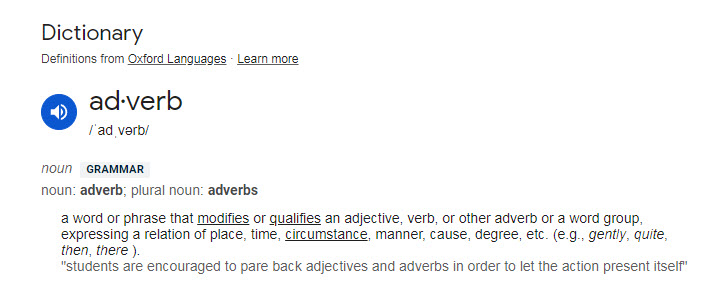I confess. I love a well-placed truly, really, apparently, and only in my writing.
Adverbs are important parts of our language. They tell us how, when, where, how often, or how much. They modify verbs and adjectives, or even other adverbs (quickly ran, moderately good, fairly often.) And they can set the tone for a whole sentence (frankly, fortunately, sadly.)
They pepper our language. “She REALLY said that?” “I LITERALLY thought I would die!” “That’s not ACTUALLY what happened.” “I ONLY did it once.”
Authors use adverbs to color their writing.
She threw the plate across the room, deliberately aiming for his head.
Did I have to use the adverb in that sentence? No. However, it made a stronger picture of the character’s action and state of mind if I did. Removing it would not change the meaning of the sentence, only the forcefulness of the writing. Could it be written without the adverb. Sure and this is how I might do it:
She threw the plate across the the room, pausing long enough to take careful aim at his head.
No adverbs, but you get the same picture of her murderous intentions.
Adverbs have gotten a bad rep in the writing world at the hands of inexperienced or lazy authors.
This is because adverbs are guilty of one thing: telling instead of showing. This makes them the crutch for lazy writing.
First drafts often read like this:
“Don’t look at me that way,” she said, softly.
“I’m just so disappointed,” he answered, angrily.
“I’m sorry,” she cried, tearfully.
“Don’t cry,” he replied, gently.
You get the idea. No one wants to read this, especially not an editor. So a more experienced author might change it to read thusly (yes, that’s an adverb):
“Don’t look at me that way,” she said, turning her head so he could barely hear her.
“I’m just so disappointed,” he answered, slamming his fist on the table.
“I’m sorry,” she cried, tears streaming down her flushed cheeks.
“Don’t cry,” he replied, suddenly ashamed of his outburst. He wiped her tears away and pulled her into his embrace.
Ok, forgive the gush; I’m a romance author. But you see the difference. One tells you with an adverb how to read the emotion in the sentence. The other shows you with action exactly what’s happening and how the characters are interacting with each other.
Why the primer on adverbs?
“I’ll tell you why!” she exclaimed, slamming her fist on the desk.
Because I wrote my book Sensible Shoes, the one that is being published, hopefully, this year, without obvious, telling adverbial dialogue tags. Are there adverbs in the book? You betcha. It’s hard to write a book without them as you can see by how many are in italics on this page.
So you can imagine my surprise when I got edit notes from my publisher that informed me there were 940 adverbs in my 73,000-word novel and that HALF of them would have to be removed.
I walked out onto the nearest ledge and sat there for three days. I complained mightily to everyone I spoke to including telemarketers, grocery checkout people, and my dental hygienist. Then I called my wise friend Chris who has experience with this sort of thing and asked him if I should pull the book? Simply call it quits? How could my book, my voice, and my self-esteem survive that kind of hatchet job?
He wisely advised me to be professional. Do what I could do and send it back to them. Then if they say it’s not enough, I can wrestle with the existential notion of the existence of this book in the hands of this publisher.
I could do that. And I have. I have excised about 350 adverbs. Is the writing better? I don’t think so. But I can live with these changes. One thing is certain, in the book I am writing now, I am careful to have no extraneous adverbs at all. After all, who needs location, time, amounts, or any of the other things adverbs tell the reader.
I’m burying all of my adverbs in a shallow grave in the backyard. Right next to the word THAT, all the exclamation points, and passive voice. We’ll talk about those another time.
